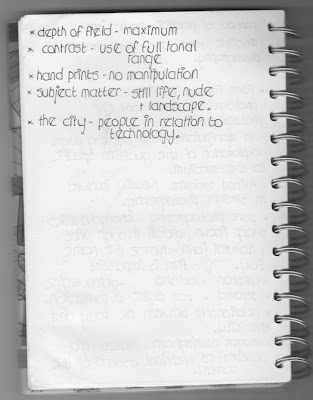Thursday, 13 December 2012
Thursday, 6 December 2012
Lecture Eight: Film Theory
Thursday, 29 November 2012
Lecture Seven: A History of Type
Labels:
A History of Type,
Lecture 7,
Lecture Notes,
OUPH401
Monday, 26 November 2012
The Portrait in Photography
Presentation from the session.
Hendrik Kerstens
This is work by Dutch photographer Hendrik Kerstens. The images I have selected are four of numerous photographs of his daughter. Here he has chosen to project his fascination with seventeenth century dutch painters upon her. This is achieved successfully via the rather severe, confrontational character of the photographs, as well as their undeniable clarity and Kerstens's use of characteristically dutch light. The first photograph in particular is rather reminiscent of the Johannes Vermeer painting entitled Girl with a Pearl Earring. The second appears to have a slightly softer focus than the other three producing a more painterly effect. Overall his work exhibits an appreciation of the fact that people are the same regardless of the age they lived in. Any association with a particular period of animate existence is established through the way we are depicted.
Labels:
OUPH401,
Session Notes,
The Portrait in Photography
Thursday, 22 November 2012
Lecture Six: Graffiti & Street Art
Self Initiated Research
This is a little bit of self initiated research spanning from the Graffiti & Street Art lecture. The majority of it comes from a book called Visible Signs by David Crow. It also includes some of my personal views informed by the lecture and additional research.
In the book, graffiti comes under the section entitled 'unofficial language'. This holds more relevance than referring to it as an 'art' because in it's best from it communicates idea's. The vernacular aspect of graffiti is interesting, how anyone can participate. There is a distinction between graffiti and street art. Street art can often lack the power and message held by vernacular graffiti. However there is also a crossover point.
Graffiti can be considered a community. It's worthwhile in that it provides an opportunity to convey a message.
Listed below are the several types of graffiti. These definitions have come from the previously mentioned book.
Ideological vandalism
Property that is destroyed to gain publicity for a particular cause, which is justified by a political belief or long-standing grievance.
Acquisitive vandalism
To acquire money or property. For example, looting vending machines or stealing signs.
Tactical vandalism
Baker and Waddon replaced this category: graffiti. A means of achieving some other end, such a bringing a production line to a halt in order to break the boredom of the work and to increase standing within peer groups.
Vindictive vandalism
Baker and Wadden changed the title of this category to problem expression. Vandalism for some form of revenge or to settle a grudge, often directed at schools.
Play vandalism
Vandalism for fun fun or through high spirits, which is motivated by curiosity or competition. For example, who can break the most windows.
Malicious vandalism
For Cohen, this is the category that includes the behaviour of young people whoa re 'breaking out, breaking away or breaking clear' and would include attacks on local authority property. He recognises this to be the category that is most difficult to understand as it appears to be 'meaningless' but provides an opportunity for them to express their boredom, frustration or despair with little chance of being caught and convicted.'
This list puts graffiti and vandalism into 6 categories. Ideological vandalism conveys a message therefore it has a reason and should not be considered vandalism. Vandalism is something that is carried for no reason at all.
With regards to graffiti, the type of communication can be categorised as low level dissent. The use of stencils has increased this factor due to their history grounded in revolution. Stencilling is an appropriate method because graffiti has to be carried out both quickly and discreetly.
In conclusion, graffiti is an undeniably useful resource when it comes the communication of a message. However it can be demeaned and abused by those using it purely to vandalise, tagging ones name for example. It's high viewership number, lack of censorship and low cost make it ideal for the communication of political messages. Graffiti artists risk imprisonment to create their work. This exhibits high levels of commitment, making graffiti just as valid as any of the more established art forms, if not more so.
Labels:
Graffiti and Street Art,
Lecture 6,
Lecture Notes,
OUPH401
Monday, 19 November 2012
Document, Survey, Construct
Labels:
Construct,
Document,
OUPH401,
Session Notes,
Survey
Monday, 12 November 2012
Surrealism
Presentation from the session.
Task 6
Task 6
Surrealism is a cultural movement with origins routed in the early 1920s. It was profoundly indebted to Freud's theory of the unconscious as well as the various method's he projected for uncovering a being's subconscious desire's, perhaps most notably dream analysis and the free-association sequences of idea's and words (Warner Marien, 2012: 253).
Surrealist work was best reflected in visual art/writings and featured elements of juxtaposition, distortion and surprise. It was particularly prevalent in photography with surrealist practitioners such as Brassai and Man Ray. The large majority of Surrealist photography lent itself to psychological innuendoes and imitations, scenarios in which something has either just happened or is about to (Warner Marien, 2010: 253). Key themes explored within Surrealist photography are the representation of sex, the body versus the mind, the unconscious, the ordinary & extraordinary and the female nude.
Labels:
OUPH401,
Session Notes,
Surrealism,
Task 6,
Tasks
Thursday, 8 November 2012
Monday, 29 October 2012
Constructivism, Bauhaus & Dada
Constructivism was an artistic/architectural movement of the 1920s that emphasised art as a practice for social purposes. It was reflected in a number of mediums. Prominent themes within the movement include the body & the city, technology/machinery, architecture, science, politics and the workers. Constructivists often worked in black & white on a 2-dimensional picture plane, making use of geometric shapes, type, found images and graphic design.
Bauhaus was a school in Germany that combined both the fine arts and crafts. It was in operation in Weimar, Dessau and Berlin between 1919 and 1933. It was famous for the approach to design that it taught and publicised.
Dada was a European avant-garde art movement of the early 20th century. The movement incorporated visual arts, poetry, literature, art theory, graphic design and theatre. Through a rejection of the subsisting standards in art through anti-art cultural works, it concentrated its anti-war politics.
Two Dolls by László Moholy-Nagy (1926)
László Moholy-Nagy was a constructivist artist/ photographer. This work is typical of the constructivist movement in that it's black and white, makes use of geometric shapes and lends itself to a graphic style. Additionally it incorporates the themes of the body & the city and architecture.
Labels:
Bauhaus,
Constructivism,
Dada.,
OUPH401,
Session Notes,
Task 5,
Tasks
Thursday, 25 October 2012
Lecture Three: Graphic Design - A Medium for the Masses
Notes from the lecture.
Self Initiated Research
A set of emoticons from the book Left to Right by David Crow (featured below). Emoticons are essentially pictures created using alphabetic forms, primarily for the purpose of texting. Phone manufactures caught on quite quickly and made the inclusion of various pictorial signatures a selectable option. This is a good example of graphic design that is used by the masses on a daily basis.
Monday, 22 October 2012
Postmodernism
Task Four
According to Photography: A Cultural History by Mary Warner Marien, "the concept of the Postmodern or Postmodernity predated what has become know as the Postmodern era"(2010). However the historical period commonly associated with the Postmodern is that of the 1960's onwards.
The image below is from the series entitled After Walker Evans by American photographer Sherrie Levine. The series consists of images re-photographed from the Walker Evans exhibition catalogue. The work is typically Postmodern in that her recycling of images underlines "the ubiquity of the copy and the insignificance of the original" (Marien, 2010).
According to Photography: A Cultural History by Mary Warner Marien, "the concept of the Postmodern or Postmodernity predated what has become know as the Postmodern era"(2010). However the historical period commonly associated with the Postmodern is that of the 1960's onwards.
There are a number of key features in this particular period common to all area's of art and design. Perhaps the most prevalent is that of the breaking of Modernist rules. Within his book The Postmodern Condition, Jean-François Lyotard argued that Postmodernism's "fertile chaos would feed a new freedom from the oppression and authority of scientific knowledge" (Marien, 2010). Marien also states that "in art circles, Postmodernism came to mean a rejection of themes and subjects that interested Modernist artists" (2010). The loss of an original is another prime aspect of the Postmodern period. Oliver Wendell Holmes "realised that the mass trade in images would change our relationship to originals; making them, indeed, little more than the source of representation" (Wells, 2010, p 22). Other key features include a re-interpretation of history, refusal to provide a narrative, a depiction of a character who appears to be cut off from reality and a tendency for artists to work outside of a singular art form.
The image below is from the series entitled After Walker Evans by American photographer Sherrie Levine. The series consists of images re-photographed from the Walker Evans exhibition catalogue. The work is typically Postmodern in that her recycling of images underlines "the ubiquity of the copy and the insignificance of the original" (Marien, 2010).
Mary Warner Marien, 2010. Photography. 3rd Revised edition Edition. Laurence King.
Liz Wells, 2009. Photography: A Critical Introduction. 4 Edition. Routledge.
Labels:
OUPH401,
Postmodernism,
Session Notes,
Task 4,
Tasks
Thursday, 18 October 2012
Lecture Two: Postmodernism
Monday, 15 October 2012
Pure and Straight Photography
The image depicts the view of the valley from a mountain situated in the Canyon de Chelly. It was taken in 1941 by American photographer and environmentalist Ansel Adams. There are a number of key features within the image typical of the Pure and Straight photographic style. The photograph possesses a maximised depth of field, resulting in sharp focus and heightened texture/detail throughout the print. The image also boasts a full tonal range and strong contrast, with dark shadows and white highlights. The work celebrates the technical aspects of the camera, has been meticulously framed in camera and undergone no manipulation. Additionally, the subject matter reflects Adams's environmental interests.
Ansel Adams was a founding member of the F64 group. The groups name stems from their use of high F numbers to achieve maximum depth of field within their images.
Labels:
OUPH401,
Pure and Straight Photography,
Session Notes,
Task 3,
Tasks
Thursday, 11 October 2012
Lecture One: Modernism
Monday, 8 October 2012
Pictorialism
The image depicts a young Alvin Langdon Coburn, shot by the American photographer Gertrude Kasebier (1852-1934) in 1902. She has chosen to photograph him leaning to the left of the frame, against a relatively simple background. The overall focus of the image is quite soft, creating a somewhat romantic aesthetic. Pictorialists favoured this photographic style as it removed any distracting details that could be associated with commercial photography. It also succeeded in creating painterly affect despite the use of a camera. Additionally the photograph has been sepia toned and appears to be printed on textured paper. According to a section from Photography: A Cultural History by Mary Warner Marien, this was “so that they resembled watercolours, evoking the earlier Victorian photographs of David Octavius Hill and Julia Margaret, which they admired and exhibited.”
Gertrude Kasebier was one of the founding members of Photo Secession in 1902. Features of her work include a simple portrait style with backdrops, primarily printed in platinum or gum bichromate emulsions. She also frequently manipulated her images by retouching the negative or re-photographing an altered print.
Alvin Langdon Coburn was an American photographer (1882-1966) and elected member of Photo Secession. His work predominately consists of cityscapes and portraits of distinguished figures. His aim was to shed the romantic aesthetic associated with Pictorialism and bring photography in step with abstract sculpture and painting. An interest in flat perspective and geometrical patterns is apparent within his body of work. He later invented the Vortoscope and produced the first Vortographs.
 |
| Portrait of Alvin Langdon Coburn by Gertrude Kasebier (1902) |
Labels:
OUPH401,
Pictorialism,
Session Notes,
Task 2,
Tasks
Monday, 1 October 2012
Triangulation
Task One
In his book 'Ways of Seeing', art critic John Berger states that contemporary viewers experience art in a manner drastically different to that of past generations. Through endless reproductions in the likes of magazines and books, and in their attainability as posters, prints and so forth, works of art have become available to all. "What this means, in theory," states Berger, "is that reproductions of works of art can be used, by anybody, for their own purposes" (Sinclair, 2012).
Berger discusses the portrayal of both men and women within art. He suggests that women are frequently depicted in an overly sexual manner, so as to please the male viewer. Additionally, he recognises the recurring motif of the mirror to be a reminder of a women's vanity. For Professor Teal Triggs "Berger presents a framework involving the 'surveyor' and the 'surveyed', as one way we might understand sexuality and the female body, her 'presence' and sense of herself, personal relationships and who is actually doing the looking" (Sinclair, 2012). Men, on the other hand, are often portrayed in an overtly masculine manner.
Berger articulates that the large majority of our thoughts and opinions are influenced by the media, family and friends. He also suggests that the image, more often than not, is affected by the photographers intent. Finally, Berger feels that nowadays artwork is rarely purchased for it's aesthetic qualities and is instead bought for its current value or with its potential future value in mind.
Notes from the session
Labels:
OUPH401,
Session Notes,
Task 1,
Tasks,
Triangulation
Tuesday, 25 September 2012
What is Context?
Subscribe to:
Comments (Atom)

































